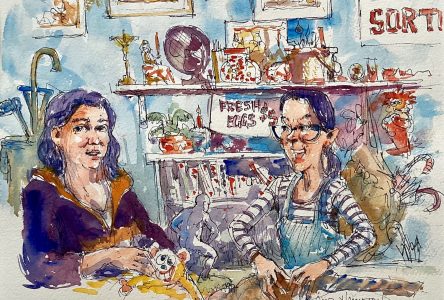Celebrating the arts in Brome-Missisquoi
Looking at the work of artist Anne Billy, we are transported back into the past, to a time before machines and quick digital convenience. Her installation work contextualizes the social histories of fibres and textiles, particularly those belonging to feminine traditions. In 2021, her residency with Arts Sutton placed a critical eye on female labour, using artefacts and archival documents from Héritage Sutton of the old Filtex factory to preserve the memory of the former employees of the mill, whose history is deeply entwined with the town of Sutton.
Her work culminated in the exhibition Anamnèse, retour à la mémoire du passé vécu et oublié, bringing to light narratives often forgotten as she examines the collective social histories of Filtex factory workers. From needlework to wooden objects, reminders of the past such as toy blocks, wheels, and scissors are suspended around the gallery, causing the audience to question their roles in the past, present, and future, as well as the hands who used them. As part of her summer residence at Arts Sutton’s D’Arts et de rêves studio, Billy invited some ex-Filtex workers to collaborate on the embroidery of a poem she composed, entitled “lasse de lasser” (tired of being tired), bringing the exhibition to an elevated level where past and present meet.
The Montreal-based artist began her practice in the early 80s after obtaining a degree in Studio Art from Concordia University, followed by a five-year stay in Milan and Paris where she had her first solo and group exhibitions. In Milan, a meeting with engraver and printer Giorgio Upiglio altered the course of her practice, giving her the privilege to develop her lithograph creations for three years in his workshop. Her early forms of artistic expression involved mostly painting and engraving, but over time grew to incorporate different materials, textiles, and found objects, leading to the creation of installations in addition to two-dimensional canvases.
“Inspiration is an inexplicable phenomenon, nurturing itself from my own experience,” she explains. “My ideas come from several sources, from themes that affect me. Whether they are personal, such as those in [my] Mémoire évanescente or Porter collections, or in the nature of collective social history in Anamnesis and Croyance, I develop them in sets of works over a period ranging from a few months to several years.”
Her interest in female labour and textiles was sparked three years ago after coming across old spools from the Biddeford Mills in Maine. Since then, she has delved deep into the social histories that affected women working in factories up until the 21st century. Her interest has only grown since she began researching and collecting these sorts of old artifacts, including spinning wheels, looms, quilts, and more.
Found objects and historical artifacts are also at the heart of her Croyance collection, which explores the relationship of faith and memory in our private lives. Religious culture takes on an intimate form in this collection of installations which is composed of needlework, found objects, and more. Billy pays homage to the craftsmanship of women whose hands and imaginations created the religious garments worn by priests throughout the years, as she posits that social history and meaning is sewn into clothing itself.
Her exhibition Anamnèse, retour à la mémoire du passé vécu et oublié will be presented at the Léo-Ayotte Center in Shawinigan from November 3 to December 11, 2022. Billy is currently continuing to research social history and artifacts in other regions of Quebec that saw the birth of textile factories in the 19th century. You can learn more about her work at annebilly.com.
This project has been made possible by the Community Media Strategic Support Fund offered jointly by the Official Language Minority Community Media Consortium and the Government of Canada.


